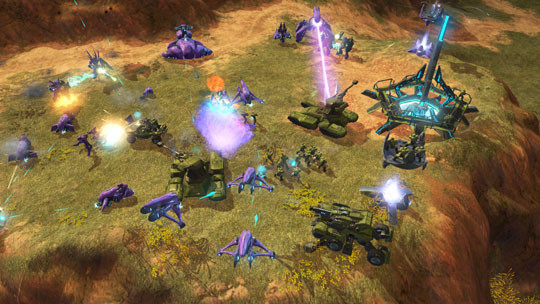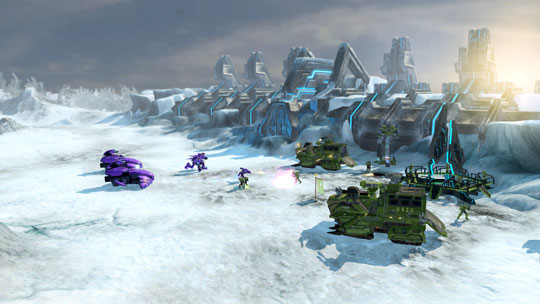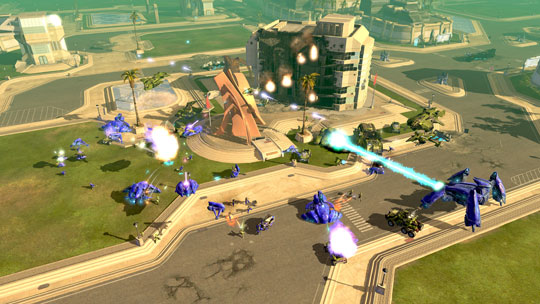To start, I must admit that I have been a Halo enthusiast for a while now. Some gamers especially love the multiplayer components of the FPS games, while I really like the story Bungie has crafted and continues to evolve through books and, hopefully, a movie at some point. It was with great geeky excitement that I started up Halo Wars. Also weighing on my mind was that this was to be Ensemble Studios’ last official production. They have been a big part of my PC-gaming enjoyment over the last twelve years with their Age of Empires series and I thank them for their efforts, talent, as well as the many hours of entertainment they have provided me.
Marty O’Donnell’s Halo Wars theme begins with the loading of the menu system, setting the perfect mood for the game to come. After taking a couple minutes to admire his musical mastery and how his themes have become so synonymous with the Halo series, I started a new campaign.

This brings me to the game’s CGI cutscenes. They are simply breathtaking. These cutscenes are so good at telling the game’s story in between most missions that if a Halo movie could not be made in ‘real life’ a CGI version from Blur Studios would suffice just as well, if not more so, given the capabilities of what is physically possible on regular film. Halo Wars’ voice actors all do great jobs in bringing their characters to life and never seem wooden or half-hearted. Believable acting is key in these kinds of story-driven cutscenes and a failure here in casting could have ruined the fourth wall entirely.
Playing the game is a very enjoyable experience and combat is fairly well-balanced to the Halo universe. Unlike most RTS titles, Halo Wars is not really ‘balanced’ with both sides being equal in capability. In the Halo universe, especially twenty years before the events of the Halo video game when Halo Wars takes place, humanity’s technology is simply not as good as the Covenant’s. While playing UNSC forces, you will have to make good use of cover and the unit-balancing trifecta: Infantry has bonuses over Air Units, Air Units have bonuses over Vehicles, and Vehicles have bonuses over Infantry. Even though your units, overall, are not as advanced as Covenant forces, by remembering those three rules you will maximize your combat effectiveness. It is said that one marine squad in a covered position is as effective as three uncovered marine squads, so plan accordingly. Covered positions are usually scattered throughout most maps and provide the player the ability to create choke points and defensive sectors.
Units often times have a special attack which, after recharging, can be activated by pressing the ‘Y’ button on a target. Be warned though that if you have a whole group of multiple unit types under your control when pressing ‘Y’, they will all attempt to use their special abilities even if they are designed for opposite purposes, e.g. one unit in the group tries to hijack an enemy target while another attempts to barrage it with missiles.

Thankfully, SPARTAN units are not the entire focus of the game. These legendary warriors are brought into the campaign in epic fashion and are used like a fine spice in a very complex meal. Too much and they would lose their potency as the gamer would get desensitized to them while not having SPARTANs enough would just displease too many fans entirely. Ensemble has balanced this nicely and you will find yourself always welcoming Group Omega, even yelling at them by their individual names, sometimes… When no one else nearby is in range to hear you.
Resources do not have to be gathered in the traditional sense, and are instead generated by Supply Pads that you build at your bases. Once built, the Spirit of Fire will happily begin sending down supply drops for your constructing enjoyment. Bases in Halo Wars are similar in usage to those found in the Battle for Middle Earth games. Once created, there are a set number of places for you to build things on. Some spaces are only good for turrets while others are only used for buildings. These structures run the gamut from unit-production to some that exist solely to upgrade your armies and bases.
Since the max population points of your side begins at 30 (upgradeable slightly later on in the game), and some units take up multiple population points, you may find that you do not have enough forces in reserve to act as base defense. For the most part, this is not too much of an issue as, once upgraded to the ‘heavy’ variety, your base’s four turrets will handle just about anything that reaches them. You can even specialize the turrets, giving them bonuses in attacking vehicles, air units, or infantry.
When we saw the controls demonstrated at this year’s CES in Las Vegas, I was impressed at how user-friendly they seemed. After having more in-depth play sessions with them, I can say they are the best RTS controls we have ever seen on a console. However, they are still sluggish when compared to a good ol’ keyboard and mouse. On a PC real-time strategy games you can usually assign groups of units into hot-keyed squads for easier selection while the fine-motor skills involved in using a mouse allow for much more precise targeting. Selecting individual units within Halo Wars, especially when the action starts intensifying can be a real challenge. Halo Wars will allow you to cycle through the types of units you have within a selected army by pressing the right trigger. This will definitely help you in your tactics but does not take the place of dedicated squad-creation. I digress…

Ensemble has added a great feature to the controls in the way of reticular tracking. By moving your reticule over a unit for a split second, it will ‘grab’ onto it, dragging the camera around with it. This is a very clever way to track your armies en route to a target without having to constantly maneuver your camera view.
Graphically, Halo Wars is a treat for the eyes and combat comes to life with vibrant weapons effects, detailed unit models, and passionate battle cries. There are some sound effects which seem to be recycled quite a bit in gameplay, especially when selecting multiple units with the right and left bumper keys (which select local and all units, respectively). The previously talked about CGI cutscenes often use unit models from the game, albeit their higher polygon count progenitors. The unit models in the game, while still nicely-detailed, obviously have level of detail settings applied to them at various distances to maximize game performance.
There were a few occasions when we found ourselves getting very frustrated with Halo Wars’ missions. There are a scattering of them that feature a countdown timer or some repetitive gimmick that takes quite a while to accomplish with no end in sight. Even worse is that sometimes a countdown timer or gimmick will appear X number minutes into the mission when you have already built up your forces in a certain configuration that proves to be ineffective given the time remaining or task assigned. Due to our review agreement with Microsoft we can’t say specifically what these missions are, suffice it to say that you will know it when you get to them. Stay the course, gamers, and you will not be disappointed in the end.
A feature we are having a blast with is the ‘Halo Timeline’. In this area of the game menu, you can browse the entire recent history of the Halo universe chronicled in the various games and books. These events are laid out in linear fashion, with many being concealed until you unlock them by finding ‘black box’ and ‘skull’ resources during missions. You will have to play the game through all the difficulty settings as well as complete all optional objectives to get all of them though.

Being that Ensemble Studios were masters at online features thanks to their years of PC-development, Halo Wars is privy to all the online modes you could ask for. Along with these online modes, the player can even choose to create offline skirmish games against AI opponents/allies to hone their skills. I had to laugh when I saw that one of the multiplayer/skirmish maps available was named ‘Blood Gulch’! It looks so much different from on high. In non-single player modes, you can chose to have a specific leader from each side lead your side. Depending on the leader you chose, you will be granted different sets of ‘leader abilities’. For instance, choosing Capt. Cutter will allow you to fire MAC rounds at targets while Sgt. Forge will enable you to drop special ‘Grizzly’ main battle tanks on the field.
Overall, Halo Wars is everything a real-time strategy game should be: Fun, easy to pickup, and hard to put down. It is not only a great time for RTS fans, but also hardcore Halo fans as well. With the relatively few issues I encountered while playing, Halo Wars is really the best console RTS to date. I only wish there was a PC version available so I could really crank up the graphical effects and resolution to see what it would look like.
Halo Wars is set to ship to North American stores on March 3rd.




